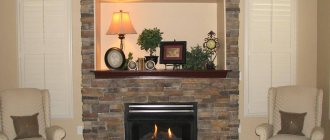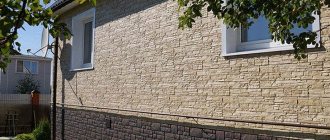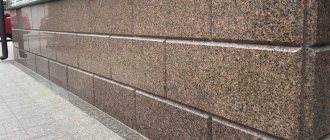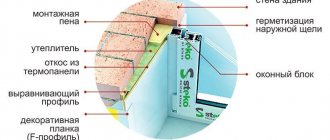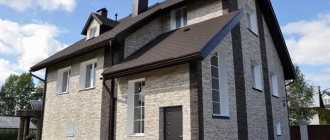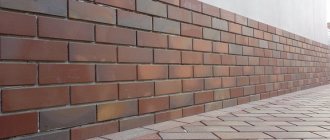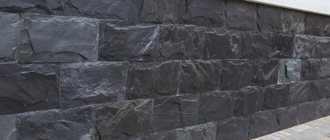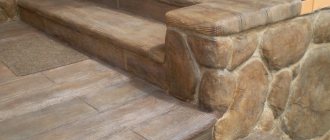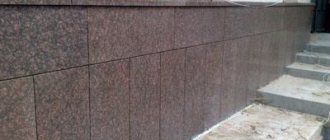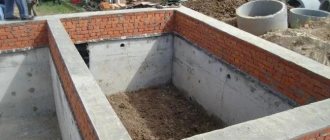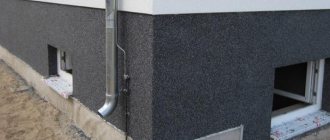Vadim
14784 1 1
Vadim October 7, 2016
As you know, the base is the visible above-ground part of the foundation of the house. The foundation is the basis of the entire structure, and the durability of your home directly depends on its safety. Consequently, protecting the base from natural and many other adversities is not a whim of the designer, but an urgent necessity. In this article we will talk about what kind of stone is currently used for such work, and I will also dwell in detail on two options for finishing the base with natural and artificial stone with your own hands.
Stone base in a wooden house.
Advantages of finishing
First of all, it is necessary to talk about the aesthetic side of the issue. The stone adds pomp and showiness to the building. Moreover, there is one interesting feature. The longer a stone structure stands, the more beautiful it becomes over time. And at the same time, the appearance of old stone can add an element of monumentality to the design.
Finishing the foundation with stone also has enough pragmatism:
- The durability of the entire structure is significantly increased.
- The strength of the base increases.
- The base is protected from moisture and wind.
- The mechanical resistance of the structure increases.
- The stone tolerates any temperature changes well.
- The material does not burn and does not emit toxic substances.
- Does not change its appearance and structure under the influence of ultraviolet radiation.
- Among the finishing materials there is a lot of stone at an affordable price.
- Due to the ease of processing, even a novice master can handle the finishing without any problems.
In addition, this facing material is distinguished by a very wide variety of colors, shapes and textures. Moreover, in addition to chaotic types that are close to natural, the production of tiles of standard sizes has been established. This also makes it easier to work with the material and is especially appealing to those who value strict geometry.
Working with wild stone Source zlatokamen.ru
An undoubted advantage is that the facing material can be glued to almost any durable surface. And the only condition for successful operation is the mandatory reinforcement of the plane before installation. This slightly increases costs, and this is already considered a disadvantage.
You can also talk about the high price of some natural types of stone. And another cost item may increase due to the need to properly cover the cladding with moisture-proof compounds. The fact is that there are types of natural stone whose hygroscopicity is very high.
Skeptics can also talk about the heavy weight of the materials. But this is a controversial topic. After all, facing stones brought to the thickness of tiles cannot in any way disturb the solidity of the foundation. And in general, most attacks on the finishing method are based on violations of various technologies.
How to install plastic (PVC) plinth panels
This type of finishing is called differently: basement or facade panels, basement siding. They have a varied appearance: to match different types of stone, tile, brick.
To install PVC panels on the base, you need to assemble a frame. It is made from wooden beams 50*50 mm. Since the finishing will be outdoors, the wood must be protected with impregnations that prevent rotting and protect against pests.
The sequence of actions is as follows:
- Using a level (laser or hydraulic level), the required finishing height is marked at all corners of the house.
- Nails are nailed in these places (screws are screwed in), a marker (string) is pulled between them, which marks the height of the base finish.
- A beam is nailed along this cord around the entire perimeter of the house. Its top edge should be precisely directed along the cord.
- If the height of one panel is not enough, you will need to make another row of timber on which two sheets will be joined, and you will also need the same strapping for the lower end of the panel.
Another finishing material for the plinth is PVC panels, which are also called “basement siding” - After about 50-60 cm, short transverse bars are packed in - they will prevent the PVC panels from sagging.
- Start installation from one of the corners. There are special elements to decorate the corner. They are secured to the sheathing with wood screws.
- The edges of the sheets of plastic facade panels are uneven - with protrusions. The edge of the first from the corner must be cut off evenly. This can be done with a jigsaw or grinder, a hand saw with a metal blade (fewer teeth, you get a smoother edge).
- The cut edge is inserted into the corner element. At the top and bottom of each panel there is perforation for fasteners. This is where the self-tapping screws are secured. But they don’t need to be tightened all the way: there needs to be some play for thermal changes in size. That's why the perforation is made of an oblong shape, and it is better to install the self-tapping screw in the middle: when changing sizes, the panel will move freely and will not burst.
- The next element is joined with a special lock and secured in exactly the same way.
Assembly is easy. Only after fastening will it be necessary to make ebbs on top: the sheathing and panels have a fairly decent volume and a gap remains at the top. You can cover it with roofing iron, as in this video. Immediately look at the technology of finishing the base with plastic panels.
In the same way, the base can be finished with corrugated board. There is only one note: it is advisable to lay insulation in the voids between the sheathing. The house will be much warmer.
Natural material
Finishing the base with natural stone is somewhat more expensive than artificial materials. But all this more than pays off with a magnificent appearance. It is also suitable for those who appreciate everything natural.
Natural facing stone Source imperial.com
But if you do not pay attention to aesthetics, then natural stone is divided into two groups, taking into account the characteristics. The first includes loose shell rocks, sandstones and limestones. Due to their porous structure, these rocks absorb moisture very strongly.
And so that the base does not become covered with a green coating after some time, the surface must be treated. The best way is hydrophobization. But the other characteristics of the stones completely cover this drawback.
The second group of natural materials has much better parameters. It includes marble and granite, as well as dolomite. The structure of these stones has a fairly good density and practically does not absorb water.
In addition, such material, even without treatment, perfectly resists frost, as well as various atmospheric aggressions. But low porosity in our case is a slight disadvantage. The adhesion of the material is extremely low. Therefore, cladding the base with natural stone using a cement-based mortar is impossible. And you need to use special glue.
Rock processing Source nashaotdelka.ru
See also: Catalog of companies that specialize in finishing materials and related work
When to start finishing the basement
It is best to finish the base after the blind area around the house has been made. In this case, the finishing material will hang over the path. As a result, even the most slanting rain or streams of water flowing down the walls will not be able to get between the wall and the blind area - the water hits the path at a distance of several centimeters from the joint. It is through this joint that water penetrates to the foundation, bringing dampness and other problems.
You need to start cladding the basement of the house after the blind area around the house has been made
One more thing. Many people are thinking about whether to insulate the basement or not. If you want to save on heating, the answer is to insulate it, just like the blind area. The unit for insulation and cladding of the base - one of the options - is shown in the photo below.
When installing an insulated base, EPS boards are laid under the finishing
When using the basement as a residential floor, there are no questions regarding insulation, since the answer is clear - insulate it, of course. But even if you don’t have a subfloor, heating costs will be much lower, and the floor in the house will become much warmer.
Fake diamond
Due to constantly emerging innovations in the chemical industry, the range of synthetic cladding products is regularly updated. And the similarity in texture to natural stone makes artificial materials very popular. And the reason lies in the price. It is significantly lower than that of natural products.
Cladding the base with artificial stone is popular for a number of reasons. The material is made extremely waterproof, and the weight of the copy is much less than that of the original. As for some types of tiles, they can generally be glued even to plasterboard walls, and not just to a strong foundation.
On cement
The most common type of artificial stone. It is done extremely simply. A high-quality cement mortar is poured into a special mold made of silicone or plastic, which has all the necessary additives to improve the properties of the material.
Raw materials and dyes are also added to imitate the appearance and texture of the desired stone. The material is very strong and durable. It's really quite heavy. But for cladding the base it is quite suitable in all respects.
Cement facing panels Source akm-fasad.ru
Polymer sand
The main filler is sand. And it is bound by various polymers. They also act as plasticizers and additives that create the texture of natural stone. The material comes to stores in the form of panels that imitate various types of masonry.
Finishing the base with artificial stone based on a polymer-sand mixture requires the installation of a sheathing made of wooden slats or metal profiles. The panels are attached to it with self-tapping screws. The installation of this lightweight material is perfectly coordinated with the insulation of the foundation protruding above the ground.
Types and features of the material
Stone has been used for finishing the basement of a house since time immemorial. It has a large arsenal of various advantages. But if earlier it was exclusively natural stone, now, in more than half of the cases, the base is finished with artificial stone.
Granite finishing.
- Natural granite has always been considered the king of basement cladding . Its natural characteristics are perfectly suited for use in this sector. This finishing stone can easily withstand both the July heat and bitter January frosts. Moreover, for granite it is absolutely not important in which climate zone it is installed. The material is presented on the market in the form of slabs with a thickness of 10 mm or more, and is also sold in solid boulders. Naturally, for finishing work we are only interested in slabs;
- Many wealthy people unknowingly order marble finishing for the base, but in this case it is not always justified . The fact that this material is incredibly expensive is not the worst thing. Marble is a rather capricious rock and can be used in warm and temperate climates. But, starting from the middle zone of our great homeland and further to the north, it is undesirable to decorate the base with marble. With increased humidity, which is always present in the base area, and temperature changes, the marble begins to crack and gradually crumble. Therefore, if you really want, then the base can be finished with granite, and then marble;
Marble finish.
- The best seller at the moment is slate . This material is also called shepherdess. It is a layered rock that has a fairly dense structure and at the same time is easy to process. Slate has excellent strength and durability characteristics. And the best part is the relatively affordable price. If you don’t have a lot of money, but you really want a natural material, then slate is your option;
- We often hear about the magnificent qualities of shell rock . If you are building a house, then shell rock blocks are a good choice. But it is not very suitable for finishing the base. The fact is that shell rock is perhaps the most porous of building materials; only cellular concrete is lighter than it. And since the material is porous, it is able to absorb moisture. As a result, after several freezing cycles, the cladding will slowly begin to crumble;
Assortment of natural materials.
- Sandstone is a fairly common rock . This material is relatively inexpensive and is quite suitable for basement cladding. The only problem is that the color range here is small, in fact, there is none at all. So, as a decorative stone, sandstone is rather weak. Although no one is stopping you from painting your base in any color you like or covering the sandstone with colored façade varnish. But we will talk about the intricacies of this process a little later;
- There are also quartzite, dolomite, lemesite, shigunite and a number of other minerals and rocks . But they can rather be classified as narrow-profile, since they are often used in the area in which they are mined.
Dolomite base.
Finishing with so-called wild stone cannot be attributed to any rock or mineral. In fact, it can be any stone, including artificial, as long as no traces of manual processing are visible on it. The easiest way out in this case is to use river or sea pebbles.
Artificial stone finishing in the form of slate masonry.
As I already said, artificial stone is now very widely used for finishing the base. Good chemists have achieved such perfection in this matter that the guarantee for most materials on the market starts at 50 years.
As such, there is no gradation by variety; the name is assigned depending on the use of a particular filler in production.
Briefly described, the production technology is based on the fact that some natural material is taken, crushed and recombined using a polymer binder. So this stone can only be called half artificial.
The ground floor is finished with stone tiles.
As you understand, the shape, color and texture of such cladding can be given any shape. To be honest, working with such material is a pleasure. After all, such tiles have clearly defined dimensions, and most importantly, they weigh an order of magnitude less. For a beginning master, this is what you need.
Separately, it is worth mentioning about flexible stone. It is positioned as a thin slice of natural stone, additionally reinforced with polymer.
This cladding looks quite decent. Flexible stone is produced in the form of wallpaper and tiles. Naturally, only tiles can be used for the base.
Appearance of flexible stone.
But to be honest, in my lifetime I have never seen a base being lined with flexible stone. Firstly, the price for it is fabulous. And secondly, the maximum thickness of the tile is about 3 mm.
Accordingly, this material cannot be considered as serious protection for the base. Plus, flexible stone is now considered one of the market leaders in terms of the number of fakes of dubious quality.
Gluing flexible stone tiles.
If you have very little money, but you really want to see a decorative stone on the base of your house, then you can line it with cement to look like a stone. I won’t undertake to say for sure, but it is believed that this is the know-how of exclusively our enterprising people.
I will tell you how to cladding with cement mortar under stone a little later, in method No. 2. And now I will tell you step by step all the intricacies of finishing with artificial and wild stone.
Video description
The following video will tell you how the plinth is finished with porcelain stoneware:
Homemade
The cheapest option for facing the foundation. But in skillful hands it has good advantages. For example, unevenness in the finishing can not be removed, but rather emphasized, passing it off as a textured relief.
To perform the operation, the cement mixture is applied to the plane in a thick layer. The shape of the individual stones is then created by hand. With bulges, roughness and seams between them. The latter can be painted with a distinctive color to further highlight the created outlines of the stone.
Preparation
Before covering the surface, it must be carefully prepared. This procedure is considered very important, since the artificial stone is laid on a fairly even surface, without serious flaws.
Process algorithm:
- Buildings built a long time ago may have a previous decorative layer; it is completely removed. Stretching reinforcing mesh over old plaster would be a mistake; the coating would be unreliable.
- The condition of the foundation is assessed. During this event, it is necessary to identify surface and hidden damage and outline a plan for further work. The feasibility of additional insulation is immediately determined.
- Cracks and crevices are the main problem. If they are not completely eliminated, they will gradually begin to grow. To eliminate defects, a set of procedures is performed. The cracks are opened using available tools, cleaned of dust and dirt and well impregnated with primers and antiseptic compounds. The putty solution is selected depending on the type of base; a cement mixture with plasticizers is more often used. It has good grip and the necessary elasticity. The gap is evenly filled, followed by removal of excess. For greater reliability, sections are reinforced with fiberglass mesh.
It is advisable to seal serious cracks in the basement of the house with special mixtures, rather than with simple cement; through damage requires additional reinforcement and strengthening - If the damage is of a through nature, then it is worth conducting a more serious assessment of the condition of the structure. Such deficiencies may indicate that the foundation needs extensive strengthening.
- The coating is treated with a deeply penetrating primer in two or three layers, each application is accompanied by drying of the surface.
- The basement area, if there are significant irregularities, needs to be leveled. For this purpose, cement compositions or tile materials are used.
On a note! Difficulties may arise when working with a pile foundation; its finishing is carried out using lathing. But if you want to use artificial stone laid with glue, then the process becomes much more complicated. In this case, a cohesive cladding is first created using glass-magnesite or cement slabs.
For wet laying of artificial stone on a pile foundation, it is necessary to install a base of durable slabs
Shapes and sizes
Cladding the base with natural stone can be divided into working with facade tiles and creativity with non-format materials. In the first case, even a novice can be trusted to finish the job. Or do the entire process yourself. A clear order and simple masonry scheme do not require special skills.
It is better to entrust irregular stone to a professional mason. And definitely with good experience in these works. After all, the different sizes of stones require careful adjustment. Otherwise, some seams will turn out to be too thick. And this will ruin the appearance.
Unformatted stone Source okolo3d.ru
In addition, the back part of an irregular stone often requires finishing. And only an experienced master will notice in time unevenness or efflorescence that will interfere with adhesion to the surface. And it is beyond the capabilities of a beginner to correctly neutralize such defects.
There is no non-format category for artificial stone. For the design of facades, the material is available in two types. As individual tiles and small panels. Working with them is not difficult.
Installation of irregular stone on a plinth
Cladding the base with stone of non-standard shapes and sizes begins with sorting. It is necessary to arrange all the purchased “plastics” into three piles according to size. Stones are divided into large, medium and small. After this, you won’t have to shovel the common pile in search of the right pebble.
There is one well-known technique that can significantly save time during installation. But they are not always used, and some consider it unnecessary and even useless. It is necessary to lay out the mosaic on the ground in advance. Since the glue sets quickly, then, during work, the time spent will more than pay off.
Stone mosaic Source depositphotos.com
No matter what light material is used, there is always a possibility that the masonry will sag. This is inevitable because the work starts from the ground. And neither compacted bedding nor a steel corner screwed to the surface of the foundation helps. The metal will still rot.
Some professionals rigidly secure the first row of middle stone masonry using anchor bolts. Taking into account the fact that subsequently it will be completely hidden behind the blind area, and additional fastening will not be visible. This creates support for subsequent rows.
Next, all large pieces are distributed onto the wall. And the voids between them are filled with medium and small elements. The glue is applied to the wall with a trowel, and to the “plate” using a notched trowel. Once the composition has set, you can grout the seams with a special grout.
How to fix porcelain tiles or clinker tiles
If heavy materials such as porcelain tiles or clinker bricks are simply placed on glue, on a plastered surface with grooves, perhaps they will stick normally. And they can even stand for some time. Even several years. But then they will begin to fall off along with the solution. Especially in places where there are no grooves or they are of insufficient depth. To improve adhesion, you can apply a layer of impregnation that improves adhesion (grip), but this is not a guarantee, especially if the material is heavy.
The same picture will happen if you glue the materials directly onto the insulation. The surface is smooth, easy to glue. But after a while the finish will fall off. Faster than with a plastered surface. There is a video about this.
To prevent this from happening, it is necessary to secure a metal painting mesh, preferably galvanized. It is secured with dowels, placing a piece of galvanized steel on the dowel-nail, the size of which is larger than the size of the cell. They are attached at the top, bottom and in a checkerboard pattern in the middle. This creates a reliable basis for material of any weight.
Glue is applied to the base and to the tiles. On the tile, remove it with a notched trowel, put it in place, tap the trowel handle and put it in place, leveling the plane. The distance between the tiles is maintained using crosses, only their thickness is taken to be significant 3-5 mm.
In general, the installation technology is similar to laying tiles. The only difference is that the glue must be special for outdoor use. The second difference: finishing materials for the plinth begin to be laid from below: they are heavy and need support. You rest the bottom row on the blind area, the second row on it, etc.
Cement stone
The imitation of large pebbles looks very nice on the base. To create it, you will have to sculpt stones by hand. Therefore, the mixed solution should have greater density. And the grade of cement must be no lower than M500.
The primed surface is abundantly moistened with water and formed stones are molded onto it. If the height of the base is more than half a meter, then it is advisable to use reinforcement. And molded stones must be immediately applied to the entire surface.
You need to give the cement time to dry. They are then wiped with a sponge soaked in water to remove hand marks. Then, using jointing or simply a wet finger, clear boundaries between the elements are outlined.
The whole highlight of such cladding is in its color. The surface is covered with blue paint. And after a couple of hours, a yellow color scheme is applied on top. This gives a complete imitation of green natural stone.
To obtain a blue color, you need to take five parts of five percent hydrochloric acid and mix them with one part of copper sulfate. The latter sets the color saturation. And for yellow you need to take iron sulfate. And the proportion will already be 1:3.
The paint will be absorbed for at least seven hours. After this, the entire surface is cleaned with a brush under running water. And after complete drying, a waterproof varnish for outdoor use is applied to it.
Briefly about the main thing
It is not difficult to cover the base with stone. And the main difficulty will be the choice of material. You'll have to decide what to give preference to. Natural stone or its high-quality imitation. After all, everyone has their own advantages and disadvantages.
But when the choice is made, you can safely begin installation yourself. After all, working with stone-look tiles is no different from the usual procedure. You can even try your hand at laying non-format materials. And in this case, strict adherence to detailed instructions will help.
Or give in to the creative impulse and make cement stones yourself. This coating is original and will delight the eye with its beauty for a long time.
Ratings 0
